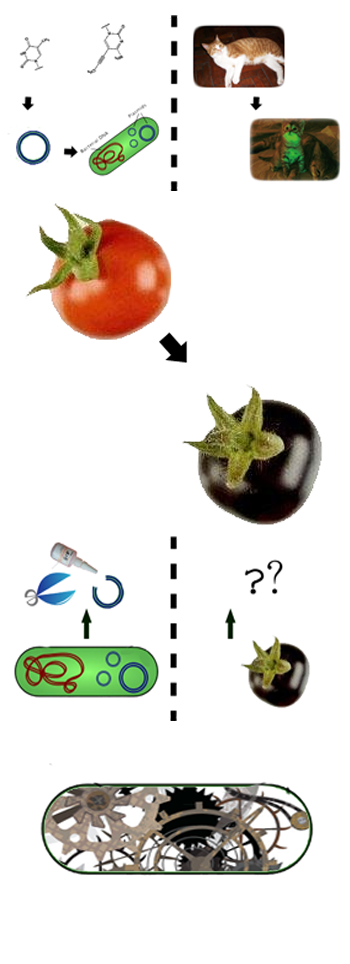Team:Peking S/project/hp/synGMO
From 2011.igem.org
(Created page with "__NOTOC__ {{https://2011.igem.org/Team:Peking_S/bannerhidden}} {{https://2011.igem.org/Team:Peking_S/back2}} {{Template:Http://2011.igem.org/Team:Peking_S/box4extra}} <font size...") |
(→Synthetic biology vs. Genetically Modified Organism) |
||
| Line 16: | Line 16: | ||
=== '''Synthetic biology vs. Genetically Modified Organism''' === | === '''Synthetic biology vs. Genetically Modified Organism''' === | ||
| - | + | <br> | |
| + | <br> | ||
Synthetic biology is broadly defined as the area of intersection of biology and engineering that is focused on the design and fabrication of biological components and systems that do not already exist in the natural world and the re-design of existing biological systems[1]. According to principles, synthetic biologists engineer complex artificial biological systems to investigate natural biological phenomena and for a variety of applications[2], including detection of chemical pollutants, environmental cleanup, disease diagnosis and treatment, etc. | Synthetic biology is broadly defined as the area of intersection of biology and engineering that is focused on the design and fabrication of biological components and systems that do not already exist in the natural world and the re-design of existing biological systems[1]. According to principles, synthetic biologists engineer complex artificial biological systems to investigate natural biological phenomena and for a variety of applications[2], including detection of chemical pollutants, environmental cleanup, disease diagnosis and treatment, etc. | ||
Revision as of 11:12, 2 October 2011
Template:Https://2011.igem.org/Team:Peking S/bannerhidden Template:Https://2011.igem.org/Team:Peking S/back2
Template:Https://2011.igem.org/Team:Peking S/bannerhidden

Human Practice
introduction|Synthetic biology vs. Genetically Modified Organism|Public Investigation|Acknowledgement&Reference
Synthetic biology vs. Genetically Modified Organism
Synthetic biology is broadly defined as the area of intersection of biology and engineering that is focused on the design and fabrication of biological components and systems that do not already exist in the natural world and the re-design of existing biological systems[1]. According to principles, synthetic biologists engineer complex artificial biological systems to investigate natural biological phenomena and for a variety of applications[2], including detection of chemical pollutants, environmental cleanup, disease diagnosis and treatment, etc.
As opposed to modifying components of living cells to achieve desired functionality, a programmable microorganism is created from scratch in this area[1]. This distinguishes it from current genetic techniques that result in genetically modified organisms at the cellular level[1]. Rather than splicing in a gene from one organism to another, or forcing a mutation in a genome for a specific purpose, synthetic biology is concerned with designing and building artificial regulatory elements into genomes or constructing a complete genome from scratch[1]. By its very nature, this is a multidisciplinary field requiring the expertise of biologist, engineers, and systems specialists among others[1].
How can we compare synthetic biology to other biotechnology, especially the process of biomedical research creating genetically modified organism? What would be the difference between these modified lifeforms and lifeforms created using a synthetic biology approach? In order to answer those questions, we outline the differences below:
• De novo & Modified: Synthetic elements would be constructed from basic elements(synthetic or purified oligonucleotides in the case of synthetic DNA) in the lab. Genetically modified organisms are emerging as part of a natural cellular process.
• Unique & Counterpart: There may be little possibility to find an identical copy with synthetic elements or networks in natural cells. The genetically modified organisms are originated from whole genomes of existing organisms – although a minimal genome (critical genes for survival) organism would be more likely.
• Programmable & Unaccessible: Synthetic elements and networks engineered in cells would be controlled by external signal in a desired pattern and its function would be established or changed. It is difficult to synthesize a new networks in a genetically modified organisms.
• Artificial & Natural: From the beginning of raw material, the end product would be an artificially assembled genome or “minimal genome” in the field of synthetic biology. Based on the characteristic of natural organism, genetically modified products differ from the artificial machines
The key difference to be noted is that genetically modified organisms are the result of introducing naturally occurring foreign or mutated DNA (genes) into the organism. Synthetic biology, in contrast, would result in the creation of elements with synthetic raw materials and with no natural counterpart[1].
 "
"
